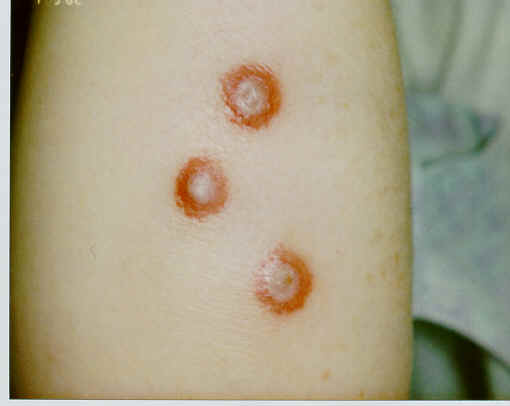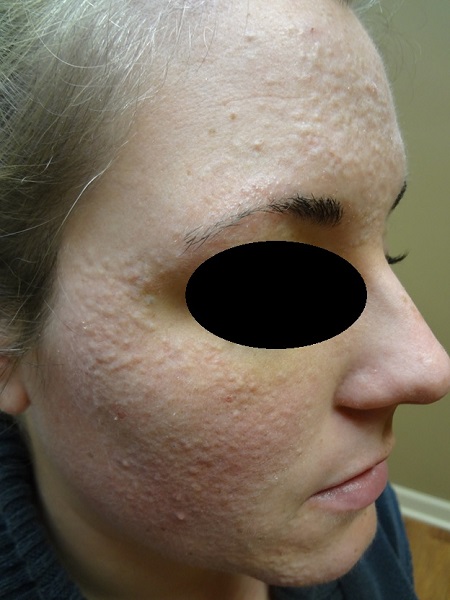CORRECT DIAGNOSIS:
Angiomyxolipoma
DISCUSSION:
We report the case of a pregnant 25-year-old female who presented with a 2 month history of a 2.4cm well circumscribed pedunculated friable nodule on her scalp. Clinically this resembled a pyogenic granuloma. A biopsy was performed which revealed angiomyxolipoma. Angiomyxolipoma is a very rare benign tumor considered as a rare variant of lipoma first described by Mai et al. in 1996. Clinically, the surface is gelatinous, beige yellow(1). To our knowledge it has been reported 12 times. It has been reported previously in the scalp twice (11,3), mediastinum(5), spermatic cord (2), knee(4),intrarticular knee(10), transverse colon(8), oral cavity (11), plantar surface of foot(12), subungually (13), thigh(9), arm(7), wrist(7), gluteal extremity (14) and hip(6). It has been reported in patients ranging from 15 to 69 years. A review of the previous literature shows that it occurs more commonly in males. Histopathological features of angiomyxolipoma reveal alternating nests of adipose and myxoid elements with multiple dilated vascular structures. To date, 12 cases of angiomyxolipoma have been reported. This is the third case of the condition presenting on the scalp.
The histopathology for angiomyxolipoma reveals lobulated architecture consisting of a mixture of adipocytic cells without lipoblast and paucicellular myxoid stroma. Intermixed thin and thick walled vessels are present. Spindle cells in myxoid areas are positive for vimentin, CD34 and negative for SMA, desmin and S100 protein expression(2-4). The blood vessels stain for vimentin and SMA(6). Adipocytes are positive for S-100 protein(6). Electron microscopy reveals spindle cells with fat vacuoles also known as preadipocytes in the transitional areas between the myxoid and lipomatous components(2). Angiomyxolipoma chromosomal translocations are t(7;13)(p15;q13) and t(8:12)(q12;13)(9).
On ultrasound it appears as a well-defined mixed echoic mass with an area of increased vascularity on a color Doppler image(4). CT and MRI reveals a heterogeneous signal intensity(4,5). Kim et al proposes that this is mostly likely due to the heterogenous mixture of vascular, adipose and myxoid components. Thus far all cases have been reported with surgical excision as the treatment used without recurrence. In conclusion, angiomyxolipoma should be included in the differential diagnosis for tumors of the scalp
TREATMENT:
Thus far all cases have been reported with surgical excision as the treatment used without recurrence.
REFERENCES:
Cho, H. S., Woo, J. Y., Hong, H. S., Yang, I., Lee, Y., Jung, A. Y., Yang, D. H., Kim, J. W., & Kim, J. W. (2013). Imaging findings of angiomyxolipoma of the spermatic cord mimicking inguinal hernia. Korean Journal of Radiology, 14(2), 218-221. https://doi.org/10.3348/kjr.2013.14.2.218. PMID: 23560114
Mai, K. T., Yazdi, H. M., & Collins, J. P. (1996). Vascular myxolipoma (“angiomyxolipoma”) of the spermatic cord. American Journal of Surgical Pathology, 20(9), 1145-1148. PMID: 8837608
Tardío, J. C., & Martín-Fragueiro, L. M. (2004). Angiomyxolipoma (vascular myxolipoma) of subcutaneous tissue. American Journal of Dermatopathology, 26, 222-224. PMID: 15167008
Kim, H. J., Yang, I., Jung, A. Y., Hwang, J. H., & Shin, M. K. (2010). Angiomyxolipoma (vascular myxolipoma) of the knee in a 9-year-old boy. Pediatric Radiology, 40(Suppl 1), S30-S33. PMID: 20182861
Hantous-Zannad, S., Neji, H., Zidi, A., Braham, E., Baccouche, I., Boudaya, M. S., & Ben Miled-M’rad, K. (2012). Posterior mediastinal angiomyxolipoma with spinal canal extension. Tunisian Medical Journal, 90(11), 816-818. PMID: 23529940
Song, M., Seo, S. H., Jung, D. S., Ko, H. C., Kwon, K. S., & Kim, M. B. (2009). Angiomyxolipoma (vascular myxolipoma) of subcutaneous tissue. Annals of Dermatology, 21, 189-192. PMID: 20436882
Lee, H. W., Lee, D. K., Lee, M. W., Choi, J. H., Moon, K. C., & Koh, J. K. (2005). Two cases of angiomyxolipoma (vascular myxolipoma) of subcutaneous tissue. Journal of Cutaneous Pathology, 32, 379-382. PMID: 16014683
Pukar, M. (2012). Angiomyxolipoma of transverse colon—a case report. Turkish Journal of Gastroenterology, 23(2), 156-159. PMID: 22703235
Sciot, R., Debiec-Rychter, M., De Wever, I., & Hagemeijer, A. (2001). Angiomyxolipoma shares cytogenetic changes with lipoma, spindle cell/pleomorphic lipoma, and myxoma. Virchows Archiv, 438, 66-69. https://doi.org/10.1007/s004280000361. PMID: 11258179
Bergin, P. F., Milchteim, C., Beaulieu, G. P., Brindle, K. A., Schwartz, A. M., & Faulks, C. R. (2011). Intra-articular knee mass in a 51-year-old woman. Orthopedics, 34(3), 223. https://doi.org/10.3928/01477447-20110124-31. PMID: 21471689
Zamecnik, M. (1999). Vascular myxolipoma (angiomyxolipoma) of subcutaneous tissue. Histopathology, 34, 180-181. PMID: 10074754
Martínez-Mata, G., Rocío, M. F., Juan, L. E., Paes, A. O., & Adalberto, M. T. (2011). Angiomyxolipoma (vascular myxolipoma) of the oral cavity: Report of a case and review of the literature. Head and Neck Pathology, 5(2), 184-187. https://doi.org/10.1007/s12105-011-0241-7. PMID: 21336614
Al Shraim, M., Hasan, M., Hawan, A., Radad, K., & Eid, R. (2011). Plantar angiomyxolipoma in a child. BMJ Case Reports. https://doi.org/10.1136/bcr.09.2011.4752. PMID: 22088110
Sánchez Sambucety, P., Alonso, T. A., Agapito, P. G., Moran, A. G., & Rodríguez Prieto, M. A. (2007). Subungual angiomyxolipoma. Dermatologic Surgery, 33(4), 508-509. PMID: 17472666
Kang, Y. S., Choi, W. S., Lee, U. H., Park, H. S., & Jang, S. J. (2008). A case of multiple angiomyxolipoma. Korean Journal of Dermatology, 46, 1090-1095.




